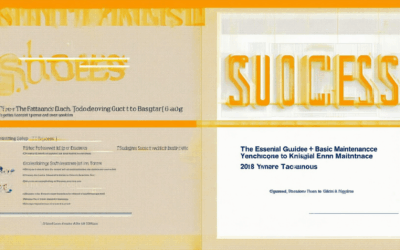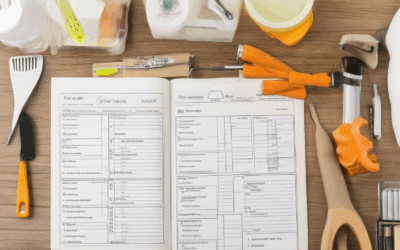Keeping your home in peak condition year-round requires thoughtful planning and regular upkeep. Whether it’s preparing for the chill of winter, the heat of summer, or the unpredictable nature of spring, seasonal house repair tips can help you maintain your property’s health and longevity. By addressing potential issues before they escalate, you can save yourself time, money, and stress in the long run. A comprehensive checklist tailored to your home’s needs ensures that no task is overlooked, helping you stay organized and proactive. From inspecting for damages to preparing for seasonal changes, this guide offers actionable steps to keep your house in top shape all year round.
Key Takeaways
– Seal Leaks and Drafts: Inspect windows and doors to prevent heat loss and reduce energy costs.
– Winterize Pipes and Roof: Clear snow from roofs and protect pipes to avoid freezing.
– Check Foundation and Gutters: Look for cracks in the foundation and ensure gutters are clear.
– Service HVAC Systems: Schedule furnace checks and replace filters to maintain efficiency.
– Dry Attics and Crawl Spaces: Use dehumidifiers to prevent moisture damage.
– Trim Trees and Secure Outdoor Areas: Remove dead branches and prepare for winter storms.
– Monitor Plumbing and Chimneys: Keep water flowing and inspect chimneys for safety.
– Prepare for Winter Storms: Secure outdoor items and sand walkways.
- Manage Two Homes Effectively: Ensure both primary and secondary homes receive regular care.
- Enhance Security Measures: Install better locks and consider surveillance for both properties.
- Optimize Rental Income: Understand tax implications for renting out your second home.
- Use Professionals for Maintenance: Hire experts for tasks like landscaping and HVAC checks.
- Store Belongings Wisely: Keep seasonal items in the second home to free up space.
- Maintain Emotional Connection: Prioritize primary home upkeep due to emotional ties.
- Set Ideal Winter Temperatures: Aim for 68°F–75°F for comfort and efficiency.
- Balance Health and Energy Use: Maintain temperatures above 64°F for health and insulate to save energy.
- Prevent Pipe Damage: Allow faucets to drip and insulate pipes.

What Home Maintenance Should Be Done Yearly?
Annual home maintenance is crucial to ensure your property remains in great shape and avoids costly repairs. Here’s a detailed checklist to guide you through essential tasks:
- Exterior Maintenance
- Inspect and clean gutters and downspouts to prevent clogs and water damage.
- Check for loose or peeling siding and repair as needed.
- Examine decks, patios, and walkways for structural issues or wear.
- Pressure wash exterior surfaces to remove dirt and grime.
- Inspect windows and doors for cracks or drafts.
- Interior Maintenance
- Clean and inspect walls for signs of peeling paint or water damage.
- Check floors for warping, cracking, or unevenness.
- Service chimneys and flues for cleanliness and proper function.
- Inspect ductwork for leaks or blockages.
- Clean and organize attics or crawl spaces.
- HVAC Systems
- Replace or clean air filters monthly, but at least annually.
- Test heating and cooling systems to ensure efficiency.
- Inspect venting ducts for obstructions.
- Check programmable thermostats for correct settings.
- Plumbing Systems
- Examine pipes for leaks or corrosion.
- Drain and flush water heaters to prevent sediment buildup.
- Check for leaks under sinks, tubs, and showers.
- Test water pressure and temperature for issues.
- Electrical Systems
- Inspect GFCI outlets and circuit breakers for functionality.
- Check for exposed wires or faulty connections.
- Test smoke detectors and carbon monoxide detectors.
- Safety Systems
- Test fire alarms and security systems.
- Inspect locks and deadbolts for proper functioning.
- Review emergency exit plans with family members.
- Landscaping
- Prune trees and shrubs to maintain growth patterns.
- Maintain sprinkler systems to ensure even watering.
- Check for invasive plants or pests.
- Appliance Checks
- Service major appliances like dishwashers, refrigerators, and ovens.
- Inspect garbage disposal for proper function.
- Check for worn-out belts or parts in appliances.
By completing these tasks annually, you’ll extend the life of your home and ensure it stays in excellent condition. For professional assistance with any of these maintenance tasks, visit our services page .
What is the maintenance checklist?
A maintenance checklist is a essential tool used to ensure that machinery, vehicles, or properties are maintained properly and consistently. It provides a organized list of tasks that need to be completed at regular intervals to prevent breakdowns, extend equipment life, and ensure optimal performance.
Components of a Good Maintenance Checklist
- Routine Inspections : Regular visual checks for wear and tear, leaks, or loose components.
- Lubrication : Applying the correct type and amount of lubricant to moving parts.
- Parts Replacement : Replacing worn-out or damaged parts as specified in manufacturer guidelines.
- Filter Replacement : Changing air, oil, and fuel filters according to the recommended schedule.
- Belts and Chains : Tensioning and securing belts and chains to prevent slippage or damage.
- Testing Gauges and Sensors : Ensuring all gauges and sensors are functioning correctly.
- Fluid Levels : Checking and topping off fluids like oil, coolant, and hydraulic fluid.
- Hoses and Pipes : Inspecting hoses and pipes for cracks, leaks, or kinks.
- Electrical Systems : Testing switches, wiring, and connections for proper function.
- Documentation : Keeping a record of all maintenance activities performed.
Sample Maintenance Checklist
Here’s an example of a general maintenance checklist for machinery:
- Machinery Maintenance :
- Check oil level and top up if necessary.
- Inspect belts for wear and adjust tension.
- Clean or replace air filters.
- Test hydraulic systems and ensure all functions work smoothly.
- Replace worn-out bearings or seals.
- Vehicle Maintenance :
- Check tire pressure and condition.
- Inspect brakes and brake fluid levels.
- Replace windshield wiper blades and fluid.
- Clean and top up engine oil and filters.
- Check battery terminals and cable connections.
- Property Maintenance :
- Inspect roofs for missing shingles or leaks.
- Check gutters and downspouts for clogs.
- Test windows and doors for proper sealing.
- Trim trees and bushes near buildings.
- Inspect foundation for cracks or damage.
Types of Equipment Maintenance
Maintenance checklists should be tailored to the specific type of equipment you’re managing. Common categories include:
- Industrial Machinery : Motors, compressors, and heavy equipment.
- Construction Equipment : Excavators, bulldozers, and cranes.
- Appliances : HVAC systems, refrigerators, and ovens.
- ** Vehicles**: Cars, trucks, and motorcycles.
Documentation Best Practices
Always document every maintenance task performed. This includes: – Date of the maintenance activity. – Description of the task(s) completed. – Any issues found and resolved. – Signature of the technician performing the work.
By customizing your maintenance checklist to suit the unique needs of your equipment or property, you can ensure consistent and effective maintenance practices. Regular updates and reviews of the checklist will help keep your operations running smoothly.

How to Maintain a Spring House
To maintain a spring house effectively, follow these essential steps:
- Inspect and Seal the Foundation: Check the foundation for cracks or gaps. Apply waterproof sealant to prevent water seeping in. Grade the surrounding land to ensure proper drainage.
- Check Windows and Doors: Ensure all windows and doors are well-sealed. Install storm windows to enhance insulation and reduce heat loss.
- Address Thermal Bridging: Insulate structural components like wooden beams and posts. Consider using rigid foam boards or spray foam to break the thermal bridge and retain heat.
- Examine Chimney and Flue: Ensure the chimney flue is tightly sealed. Adjust or replace the damper to maintain proper ventilation and prevent cold air infiltration.
- Maintain the Heating System: Regularly service the stove or fireplace. Check the venting system for leaks and ensure the stove operates efficiently.
- Monitor Moisture Levels: Use a dehumidifier to control moisture, preventing wood rot and warping. Check floors for sagging or unevenness, which may indicate underlying water damage.
- Inspect Electrical Systems: Test GFCI outlets and ensure all electrical systems are grounded properly for safety. Schedule regular checks to prevent malfunctions.
- Professional Inspection: Hire a professional inspector to evaluate the structure annually. They can identify issues and recommend tailored solutions.

How to Take Care of Your House in the Winter
To ensure your home stays safe and comfortable during the colder months, follow these essential maintenance tips:
- Check for drafts and seal leaks. Inspect windows and doors for gaps or cracks. Consider installing weatherstripping or caulking to reduce heat loss. Properly sealing your home can save energy and lower heating costs.
- Inspect your roof and gutters. Clear snow and debris from your roof to prevent ice dams. Clean out gutters to ensure water flows freely and avoids damage to your fascia or foundation.
- Examine your foundation. Look for signs of cracking or settling. If you notice issues, contact a professional for repair services to prevent further damage from frost heave or moisture.
- Protect your pipes. Drain outdoor hoses completely and wrap exposed pipes to prevent freezing. Keep your interior pipes insulated to reduce the risk of bursting.
- Test your HVAC system. Schedule a routine service for your furnace or heat pump. Replace filters and ensure your system is running efficiently to maintain optimal indoor temperatures.
- Keep attics and crawl spaces dry. Inspect these areas for moisture or mold growth. Use dehumidifiers or fans to keep spaces dry and prevent damage to insulation or structural materials.
- Trim tree branches. Remove any dead or overhanging branches that could fall onto your roof or block your gutters. This reduces the risk of damage caused by heavy snow or ice.
- Monitor your plumbing systems. Know where your main water shut-off valve is located in case of frozen pipes. Run your taps slightly to keep water moving through pipes and prevent freezing.
- Inspect your chimney and flues. Check for cracks or blockages. Hire a professional to clean and inspect your chimney to prevent carbon monoxide poisoning and fire hazards.
- Prepare for winter storms. Trim trees, secure outdoor furniture, and remove electrical cords from areas prone to moisture. Sand walkways to prevent slips and falls.
Additional Tips:
- Consider installing storm doors to improve energy efficiency and reduce draftiness.
- Use a programmable thermostat to maintain consistent temperatures, saving energy during winter months.
- Invest in high-quality window coverings like thermal curtains to retain heat and reduce heat loss.
- For added warmth, install radiant heaters in frequently used areas or consider whole-house humidification to combat dry air.
By following these guidelines, you can protect your home from the harsh effects of winter and ensure it remains in great shape come springtime.
What Do Snowbirds Do With Their Houses?
Snowbirds, those who relocate to warmer climates during colder months, manage their properties thoughtfully. Here’s how they handle their houses:
Primary Residence Care
They maintain their primary home, ensuring regular maintenance tasks are completed. This includes lawn care, seasonal decorations, and routine inspections. Sometimes, they hire professionals to check on the house while they’re away.
Second Home Maintenance
Their second home may receive less frequent attention but still requires annual tasks. They often store seasonal items like boats or winter gear there, accessing them only during visits.
Security Measures
Both properties may require enhanced security measures, such as improved locking systems or surveillance equipment. They might also invest in specialized insurance coverage for both homes.
Financial Considerations
Renting out their second home can provide extra income. However, managing two properties involves tax considerations and financial planning to optimize rental income and deductions.
Professional Help
They often rely on professionals for tasks like landscaping, pool maintenance, and HVAC system checks in both locations. Utilities like electricity and plumbing also need attention, especially in colder climates.
Belongings Storage
Seasonal items and larger possessions, like boats or RVs, are stored in the second home to free up space in their primary residence.
Emotional Attachment
There’s often an emotional connection to their primary home, prompting careful upkeep. The second home, while important, may feel less personal, affecting how they treat it.

How Cold is Too Cold for a House in Winter?
The ideal indoor temperature for comfort during winter varies by personal preference, but generally, temperatures below 68°F may feel too cold for many. However, there are several factors to consider:
- Thermal Comfort:** The World Health Organization (WHO) recommends maintaining a temperature of at least 64°F when people are at home. This helps prevent discomfort and health issues associated with cold temperatures.
- Health Considerations:** Infants and the elderly may require warmer temperatures, around 70°F or higher, to stay comfortable and prevent illness.
- Energy Efficiency:** Keeping your home too cool can lead to higher energy bills. Sealing windows and optimizing your HVAC system can help maintain a balanced temperature while reducing energy waste.
- Safety:** Extreme cold can cause pipes to freeze or burst, leading to costly repairs. Insulating your home and allowing faucets to drip can prevent this issue.
For added warmth and efficiency, consider installing double-pane windows or upgrading your furnace. These improvements can enhance comfort while lowering energy costs. Always consult professionals for installation to ensure optimal performance.
For more tips on maintaining a comfortable home environment, visit our home maintenance guide .
Conclusion: While personal comfort levels may vary, aiming for a temperature between 68°F and 75°F is generally suitable for most households. Prioritize health, safety, and energy efficiency when determining your ideal winter home temperature.




0 Comments